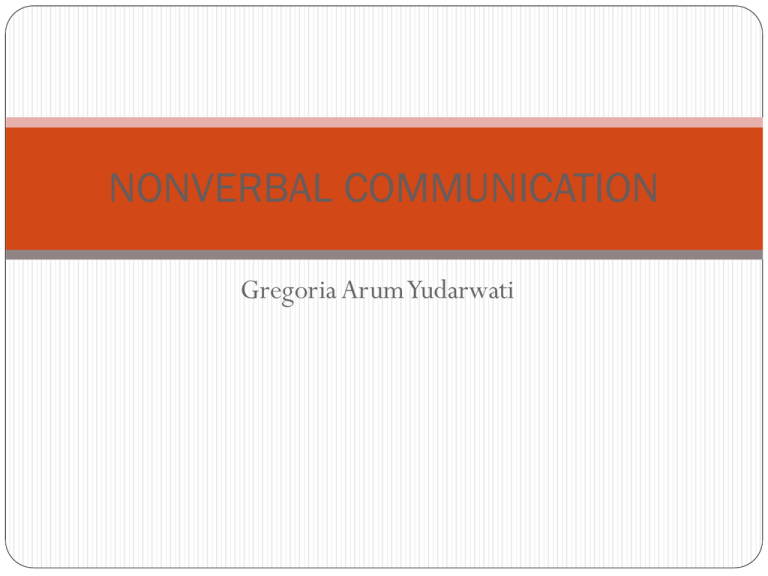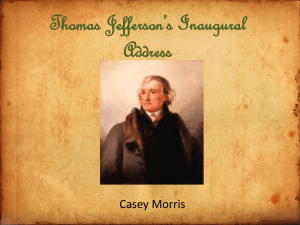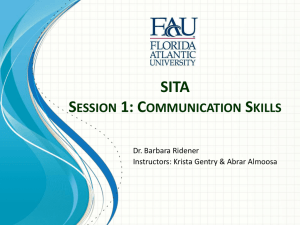NON VERBAL COMMUNICATION
advertisement

NONVERBAL COMMUNICATION Gregoria Arum Yudarwati “To appreciate the importance of nonverbal communication to human interaction, you should reflect a moment on the countless times in a day that you send and receive nonverbal messages” (Samovar et.al.2007:195) approximately 60-65% of social meaning is derived from nonverbal behaviour nonverbal messages are perceived as more reliable than verbal messages (Guerrero et.al. 1999) ‘speakers of every language accompany their words with non verbal signals that serve to mark the structure of their utterances” Peter Farb (1973:224) Verbal based primarily on symbols Non verbal based on signals/signs Verbal com – unrestricted sending capacity Non verbal com- restricted sending capacity Formal v informal code systems Neuliep 2006:288 3 Defining Nonverbal Communication “Communication occurs whenever a person attempts to send a message or whenever a person perceives and assigns meaning to behaviour” (Frey et.al. 2000) “Nonverbal Communication involves all those nonverbal stimuli in a communication setting that are generated by both the source and his or her use of the environment and that have potential message value for the source or receiver” (Samovar et.al. 2007:197). Characteristics Nonverbal communication is multidimensional Multidimensionality: messages are sent simultaneously and often interacts with verbal communication : • repeating • complementing • substituting • regulating • contradicting (Samovar et.al. 2007) Continued… Nonverbal messages are organised into codes “Codes are organised message systems consisting of a set symbols and rules for their use” (Guerrero 1999:7). Each code is communicated by a different nonverbal channel, such as body, space between people, etc. Nonverbal messages are functional (Guerrero 1999) - creating impressions - managing interaction - expressing emotion - sending relational messages - deceiving and detecting deception - sending messages of power and persuasion Continued… Nonverbal messages are influenced by context (Guerrero 1999) The relational context The situation Culture Judging internal states (Samovar 2007) shows attitudes, feelings, and emotions CLASSIFICATION APPEARANCE AND ADORNMENT CUES KINESIC CUES : Body behaviour Facial expressions Eye contact and gaze VOCALICS : SOUND AND SILENCE (PARALANGUAGE) CONTACT CODES: PROXEMICS (SPACE AND DISTANCE) AND HAPSTICS (TOUCH) TIME AND PLACE CODES: CHRONEMICS (Leathers 1997:12) APPEARANCE AND ADORNMENT CUES General appearance “We tend to draw on a person’s attractiveness, dress, and personal artefacts to make inferences (often faulty) about that individual’s intelligence, gender, age, approachability, financial well-being, class, tastes, values, and cultural background” (Ruben 1992:213). Skin colour “Skin colour is the first racial marker…and can be considered the most salient of phenotypic attributes” (Vazquez et.al. 1997:377) “In many respects, permanent skin colours have been the most potent body stimulus for determining interpersonal responses in our culture” (Knapp & Hall in Samovar 2007:202) Continued Attire (clothing) “Clothing can be used to convey economic status, education, social status, moral standards, athletic ability and/or interests, belief system (political, philosophical, religious), and level of sophistication” (Adler & Rodman in Samovar 2007:203). Clothing also can be a reflection of a culture’s value orientation. Sikhs in white turbans, Japanese in kimonos, Hasidic Jews in blue yarmulkes, Africans in white dashikis, etc – It is important to be tolerant of these external differences so that these will not impede communication. (Samovar 2007) Continued… Olfactics (the study of communication via smell) “Smell can stimulate memory and affect our health and moods” (Furlow 1999:118). “Americans do not seem to consciously rely on their sense of smell for very much interpersonal information unless the smell is unusually strong or inappropriate to the situation. Nevertheless, people (at least in many parts of Europe and North America) do seem to have an ongoing interest in how others perceive and evaluate their olfactory cues” (Aune 1999:127). KINESICS Kinesics cues are those visible body shifts and movements that can send messages about: 1. Attitude towards the other person 2. Emotional state 3. Desire to control the environment “How people hold themselves, stand, sit, and walk communicates strong nonverbal messages…Every move you make potentially communicates something about you to others” (Morreale, Spitzberg, and Barge in Samovar 2007:204) Continued… Posture Posture offers insight into a culture’s deep structure. For example: in Japan, the bow is much more than a greeting. Low posture is an indicator of respect. Sitting Gesture “Some gestures that are positive, humorous, or harmless in some cultures can have the opposite meaning in other cultures” (Samovar 2007) Pointing Idiosyncratic gestures (gestures whose meanings are the feature and property of a particular culture) Beckoning Acceptance and understanding Amount and size of the gestures Facial Expression reflect course of action convey messages of social submissiveness and dominance tell others how interested you are signal your degree of involvement indicate your level of comprehension about the moment divulge whether or not your reactions are spontaneous or managed” (Samovar 2007:208) There are at least six facial expressions that are innate, universal and carry the same basic meaning throughout the world: happiness, sadness, fear, anger, disgust, and surprise. Eye contact and gaze Eyes are the primary centre of visual attention: 43.4% of the time, attention is focused on the eyes than other part of body 12.6% of the time, attention is focused on the mouth (Janik, Goldberg, and DeLosse in Leathers 1997:54) Communicative functions (Leathers 1997:54) Indicate degrees of attentiveness, interest, arousal Help initiate and sustain intimate relationships Influence attitude change and persuasion Regulate interaction Communicate emotions Define power and status relationships Assume a central role in impression management VOCALICS (PARALANGUAGE) (Samovar 2007) Functions: The emotion function The impression management function The regulatory function Vocal characteristics (laughing, crying, yelling, moaning, whining, belching, yawning), Vocal quality (volume, pitch, rhythm, tempo, resonance, tone) Loudness and softness deliver different meanings in different cultures. SPACE AND DISTANCE (PROXEMICS) Functions (Leathers 1997) : The impression management The affiliation function The privacy function Personal distance (Hall 1968) Intimate: actual contact to 18 inches, close relationships. Casual-personal: 1.5 – 4 feet, casual conversations, friends Social: 4-12 feet, strangers, business Public:12-25 feet, formal meetings, lectures Continued… Territoriality (Lyman & Scott 1999) Public territories Home territories Interactional territories Body territories Sitting Furniture arrangement, e.g. feng shui (the art of manipulating the physical environment to establish harmony with the natural environment to achieve happiness, prosperity, and health) TOUCH Functions (Leathers 1997): Emotional support function Power function Affiliation function Other functions: an interaction signal in greetings, farewell, congratulations, or in ceremonies. TIME (CHRONEMICS) A culture’s conception of time (Samovar 2007): Informal time Punctuality Pace Perception of past, present, and future Cultures that have past-oriented philosophy tend to apply past events to similar new situations – resisting change Present-oriented cultures – emphasize enjoying and living in the moment Future oriented cultures – change, taking chances, and optimism Continued… Hall’s monochronic and polychronic classification A monochronic view of time believes time is a scarce resource which must be rationed and controlled through the use of schedules and appointments, and through aiming to do only one thing at any time” (Samovar 2007:223). A polychronic view of time believes sees the maintenance of harmonious relationships as the important agenda, so that use of time needs to be flexible in order that we do right by the various people to whom we have obligations” (Samovar 2007:223-224) Lessons for cross cultural communicators Nonverbal communication is culture-bound Be sensitive, aware of, and understand the cultural factors that influence nonverbal communication Ethnocentric behaviour REFERENCES Aune, K. R. 1999, ‘The effects of perfume use on perceptions of attractiveness and competence’, In L. K. Guerrero, J. A. DeVito & M. L. Hecht (Eds.), The Nonverbal Communication Reader, Waveland Press, Illinois, pp. 126-132. Braithwaite, C. A. 1999, ‘Cultural uses and interpretations of silence’, In L. K. Guerrero, J. A. DeVito & M. L. Hecht (Eds.), The Nonverbal Communication Reader , Waveland Press, Illinois, pp. 163-172. Frey, L.R., Botan, C. H., Friedman, P. G., & Kreps, G. L. 1991, Investigating Communication: an Introduction to Research Methods, Prentice Hall, Englewood Cliffs, NJ. Furlow, B. F. 1999, ‘The smell of Love’, In L. K. Guerrero, J. A. DeVito & M. L. Hecht (Eds.), The Nonverbal Communication Reader, Waveland Press, Illinois, pp. 118-125. Guerrero, L. K., DeVito, J. A., & Hall, E. T. 1999, ‘Perspective on nonverbal communication codes, functions, and contexts’, In L. K. Guerrero, J. A. DeVito & M. L. Hecht (Eds.), The Nonverbal Communication Reader, Waveland Press, Illinois, pp. pp. 3-18. Hall, E.T. 1968, ‘Proxemics’ , Current Anthropology, Vol 9, No 2-3, pp.83-108. Jaworski, A. 1999, ‘The power of silence in communication’, In L. K. Guerrero, J. A. DeVito & M. L. Hecht (Eds.), The Nonverbal Communication Reader, Waveland Press, Illinois, pp. 156-162. Leathers, D. G. 1997, Successful Nonverbal Communication principles and Applications (3 ed.), Allyn & Bacon, Boston. Lyman, S. M., & Scott, M. B. 1999, ‘Territoriality a neglected sociological dimension’, In L. K. Guerrero, J. A. DeVito & M. L. Hecht (Eds.), The Nonverbal Communication Reader, Waveland Press, Illinois, pp. 175-183. Matsumoto, D. 1996, Unmasking Japan, Myths and Realities about the Emotions of the Japanese, Stanford University Press, California. Ruben, B. D. 1992, Communication and Human Behaviour, Englewood Cliff, NJ, Prentice Hall. Samovar, L. A., Porter, R. E., & McDaniel, E. 2007, Communication Between Cultures (6 ed.), Wadsworth/Thomson Learning, Belmont, CA. Vazques, L. A., Garcia-Vazques, E., Bauman, S. A., & Sierra, A. S. 1997, ‘Skin color, acculturation, and community interest among Mexican American students: a research note’, Hispanic Journal of Behavioral Sciences, Vol. 19, No. 3, pp.377-386.









